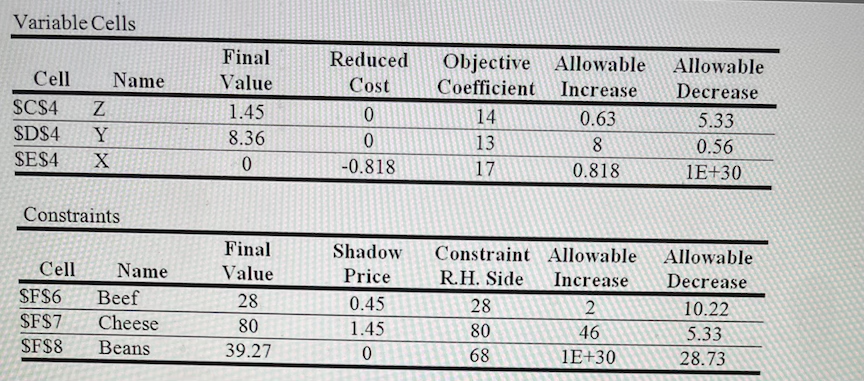Taco Loco Taco Loco is considering a new addition to their menu. They have test marketed a number of possibilities and narrowed them down to three new products, X, Y, and Z. Each of these products is made from a different combination of beef, beans, and cheese, and each product has a price point. Taco Loco feels they can sell an X for $17, a Y for $13, and a Z for $14. The company's management science consultant formulates the following linear programming model for company management. Max R = 14Z + 13Y + 17X subject to: Beef 2Z + 3Y + 4X ≤ 28 Cheese 9Z + 8Y + 11X ≤ 80 Beans 4Z + 4Y + 2X ≤ 68 X,Y,Z ≥ 0 The sensitivity report from the computer modelis attached onto the image. 3-1) The local cheese vendor offers to sell Taco Loco 200 pounds of cheese for these three products. Taco Loco should: A) refuse to buy any cheese. B) buy less than 80 pounds of cheese for $1.45 per pound. C) buy 46 pounds or less of cheese for $1.45 or less. D) buy at least 126 pounds of cheese for $5.33 or less. 3-2) The optimal quantity of the three products and resulting revenue for Taco Loco is: A) 28 beef, 80 cheese, and 39.27 beans for $147.27. B) 10.22 beef, 5.33 cheese, and 28.73 beans for $147.27. C) 1.45 Z, 8.36 Y, and 0 Z for $129.09. D) 14 Z, 13 Y, and 17 X for $9.81. 3-3) Taco Loco is unsure whether the amount of beef that their computer thinks is in inventory is correct. What is the range in values for beef inventory that would not affect the optimal product mix? A) 26 to 38.22 pounds B) 27.55 to 28.45 pounds C) 17.78 to 30 pounds D) 12.22 to 28 pounds 3-4) How many pounds of beans will Taco Loco have left over if they produce the optimal quantity of products X, Y, and Z?
Taco Loco
Taco Loco is considering a new addition to their menu. They have test marketed a number of possibilities and narrowed them down to three new products, X, Y, and Z. Each of these products is made from a different combination of beef, beans, and cheese, and each product has a price point. Taco Loco feels they can sell an X for $17, a Y for $13, and a Z for $14. The company's management science consultant formulates the following linear programming model for company management.
Max R = 14Z + 13Y + 17X subject to:
Beef 2Z + 3Y + 4X ≤ 28 Cheese 9Z + 8Y + 11X ≤ 80 Beans 4Z + 4Y + 2X ≤ 68 X,Y,Z ≥ 0
The sensitivity report from the computer modelis attached onto the image.
3-1) The local cheese vendor offers to sell Taco Loco 200 pounds of cheese for these three products. Taco Loco should:
A) refuse to buy any cheese.
B) buy less than 80 pounds of cheese for $1.45 per pound.
C) buy 46 pounds or less of cheese for $1.45 or less.
D) buy at least 126 pounds of cheese for $5.33 or less.
3-2) The optimal quantity of the three products and resulting revenue for Taco Loco is:
A) 28 beef, 80 cheese, and 39.27 beans for $147.27.
B) 10.22 beef, 5.33 cheese, and 28.73 beans for $147.27.
C) 1.45 Z, 8.36 Y, and 0 Z for $129.09.
D) 14 Z, 13 Y, and 17 X for $9.81.
3-3) Taco Loco is unsure whether the amount of beef that their computer thinks is in inventory is correct. What is the range in values for beef inventory that would not affect the optimal product mix?
A) 26 to 38.22 pounds
B) 27.55 to 28.45 pounds C) 17.78 to 30 pounds D) 12.22 to 28 pounds
3-4) How many pounds of beans will Taco Loco have left over if they produce the optimal quantity of products X, Y, and Z?
A) 28.73
B) 39.27
C) 0
D) 1E + 30
3-5) What is the increase in revenue if Taco Loco purchases 20 pounds of cheese for $1 and uses it optimally?
A) $0
B) $9.09
C) $29.00 D) $158.18

Trending now
This is a popular solution!
Step by step
Solved in 2 steps with 6 images









